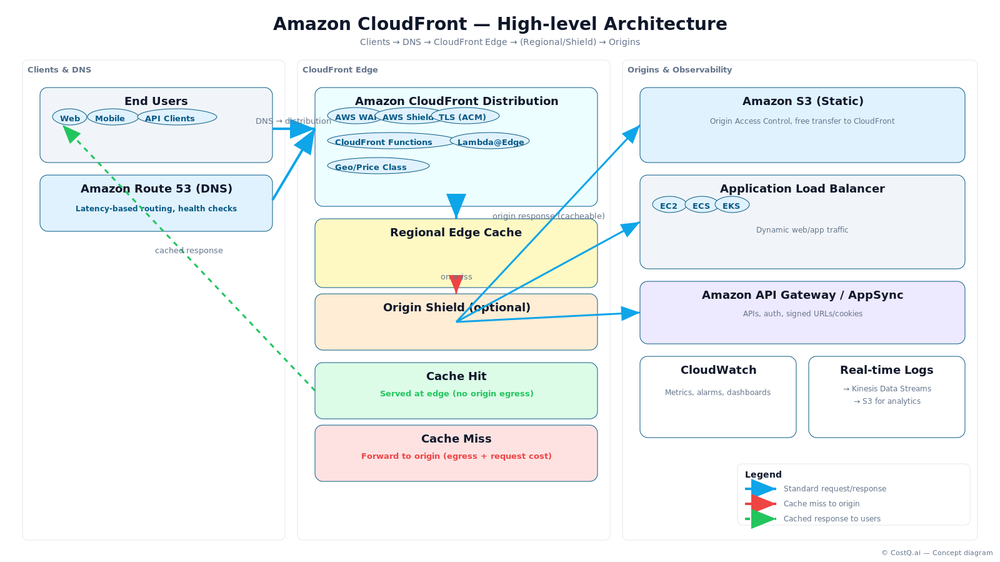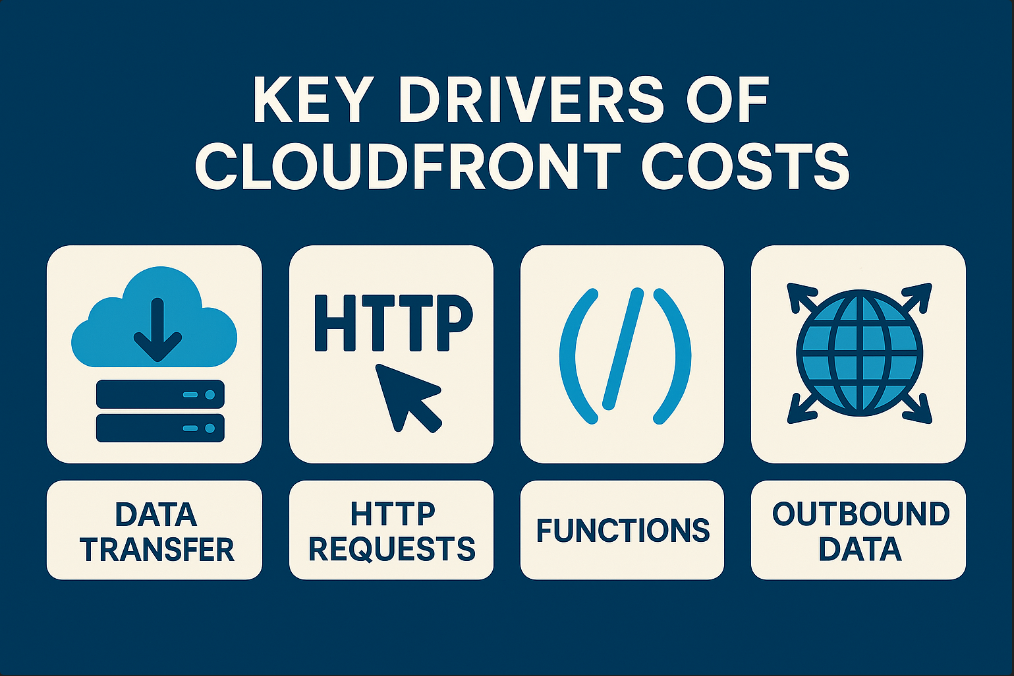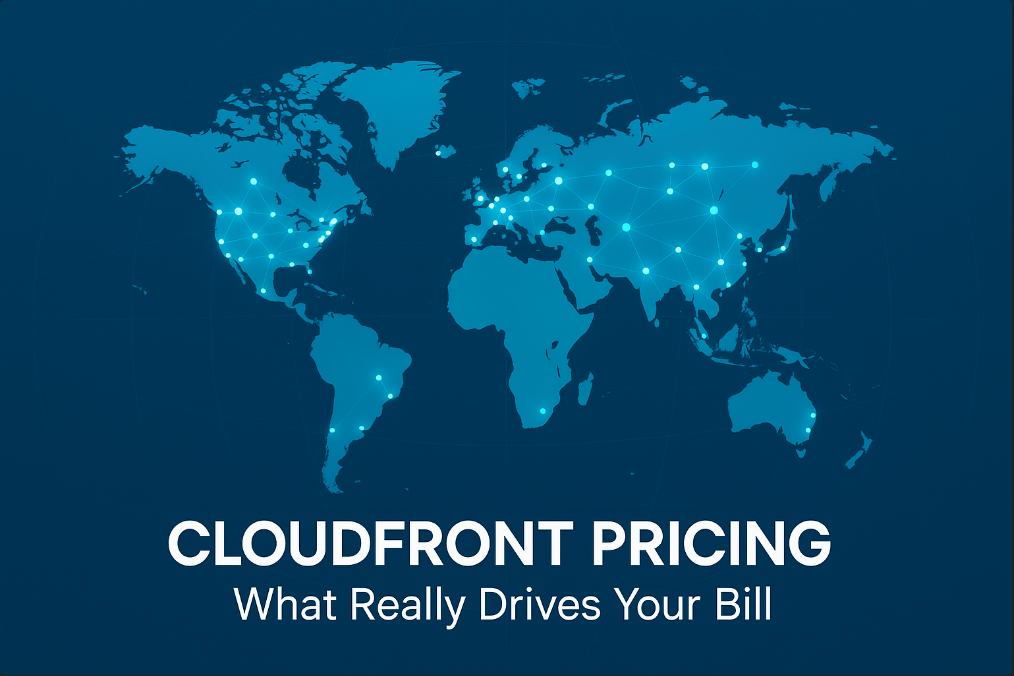Key Insight: Understanding the true cost of CloudFront is crucial for any business leveraging Amazon’s Content Delivery Network. While CloudFront offers exceptional performance and global reach, its complex pricing structure can lead to unexpected bills that catch even experienced IT teams off guard. Recent case studies show businesses paying 30-50% more than necessary due to poor cost optimization strategies.
Whether you’re evaluating CloudFront for the first time or looking to optimize existing costs, this comprehensive guide breaks down every aspect of CloudFront pricing, compares it with alternatives, and provides actionable strategies to minimize your CDN expenses without sacrificing performance.
By the end of this article, you’ll have a clear understanding of CloudFront’s pricing model, know exactly what drives your costs, and possess practical techniques to optimize your CDN spending for maximum ROI.
What Is Amazon CloudFront?

Amazon CloudFront is AWS’s global content delivery network (CDN) service that accelerates the distribution of static and dynamic web content, APIs, and streaming media. With over 400 edge locations across 90+ cities worldwide, CloudFront caches your content closer to users, reducing latency and improving user experience.
CloudFront integrates seamlessly with other AWS services like S3, EC2, and Lambda@Edge, making it a natural choice for businesses already invested in the AWS ecosystem. The service supports various content types, from simple web pages to live video streaming and software downloads.
What sets CloudFront apart is its pay-as-you-use model with no upfront costs or long-term commitments. However, this flexibility comes with pricing complexity that requires careful understanding to manage costs effectively. [Learn More About CloudFront]
CloudFront Pricing Overview in 2025

CloudFront pricing operates on a multi-dimensional model based on several key factors. Understanding each component is essential for accurate cost forecasting and optimization.
Data Transfer Costs
Data transfer represents the largest portion of most CloudFront bills, accounting for 60-80% of total costs. AWS CloudFront cost for data transfer varies significantly by geographic region:
| Region | First 10 TB/month | Over 5 PB/month |
|---|---|---|
| North America and Europe | $0.085 per GB | $0.020 per GB |
| Asia Pacific | $0.140 per GB | Similar volume discounts |
| South America | $0.250 per GB | Volume discounts apply |
| Middle East and Africa | $0.220 per GB | Volume discounts apply |
These regional variations can create significant cost differences depending on your user base distribution. A global application serving users primarily in Asia Pacific will face substantially higher costs than one focused on North American markets.
Request and Function Charges
Beyond data transfer, CloudFront charges for HTTP/HTTPS requests and various function executions:
- HTTP Requests: $0.0075 per 10,000 requests in North America/Europe
- HTTPS Requests: $0.010 per 10,000 requests (33% premium over HTTP)
- Lambda@Edge Functions: $0.60 per 1 million executions plus compute time
- CloudFront Functions: $0.10 per 1 million invocations (significantly cheaper than Lambda@Edge)
Warning: Request charges often surprise businesses with high-traffic, small-file scenarios. An API serving millions of small JSON responses can generate substantial request fees even with minimal data transfer.
Regional Edge Caches and Security Add-ons
CloudFront’s advanced features come with additional costs that can impact your overall budget:
- Origin Shield: $0.0050 per 10,000 requests plus standard data transfer charges
- Real-time Logs: $0.01 per 1 million log lines delivered to Kinesis Data Streams
- Field-level Encryption: $0.02 per 10,000 requests requiring encryption/decryption
- Dedicated IP SSL Certificates: $600 per certificate per month (versus free SNI SSL)
These add-ons can significantly increase costs for specific use cases, making careful feature selection crucial for cost management.
Key Drivers Of CloudFront Costs

Several critical factors determine your final CloudFront bill, many of which can be optimized with proper planning and configuration:
Geographic Distribution: The location of your users dramatically impacts costs due to regional pricing variations. Applications serving users in expensive regions like South America or Asia Pacific can face 2-3x higher per-GB costs compared to North American traffic.
Cache Hit Ratio: Your cache effectiveness directly correlates with cost efficiency. A cache hit ratio below 85% indicates potential optimization opportunities. Improving cache hit ratios reduces origin server requests and associated data transfer costs from your origin.
Content Type and Size: Large files benefit more from CloudFront’s volume discounts, while small, frequently requested files may generate disproportionate request charges. Video streaming typically offers better cost efficiency than API responses.
Security Requirements: HTTPS usage, field-level encryption, and dedicated SSL certificates all carry premium pricing. Balancing security needs with cost considerations requires careful evaluation of actual requirements versus nice-to-have features.
Usage Patterns: Predictable, steady traffic benefits from reserved capacity pricing, while spiky or unpredictable usage may result in higher per-unit costs but lower overall expenses during low-traffic periods.
CloudFront Pricing vs Other CDNs (Cloudflare, Akamai, Fastly)
Understanding how CloudFront charges explained compare to alternatives helps inform strategic decisions about CDN selection and cost optimization.
CloudFront vs Cloudflare: Cloudflare offers lower costs, while AWS CloudFront delivers lower latency for AWS-hosted content. Cloudflare’s flat-rate pricing starts at $20/month for the Pro plan, making it more predictable but potentially more expensive for low-traffic sites. CloudFront’s pay-as-you-use model can be more cost-effective for variable or growing traffic.
CloudFront vs Akamai: Akamai typically costs 20-40% more than CloudFront for equivalent traffic volumes but offers enterprise-grade features and premium support. For high-volume applications requiring advanced security features, Akamai’s premium may be justified.
CloudFront vs Fastly: Fastly’s real-time purging and edge computing capabilities come at a premium, typically 15-25% higher than CloudFront for similar usage patterns. However, Fastly’s instant cache invalidation can reduce origin server costs and improve user experience.
Cost Comparison Example
For a typical e-commerce site serving 100GB/month primarily to North American users:
• CloudFront: ~$8.50/month (data transfer) + ~$7.50/month (requests) = $16/month
• Cloudflare Pro: $20/month flat rate (includes additional security features)
• Fastly: ~$18-22/month depending on configuration and cache hit ratio
CloudFront and Related AWS Costs
CloudFront costs often intertwine with other AWS services, creating complex cost relationships that require holistic optimization approaches.
S3 Integration Costs: When using S3 as your CloudFront origin, you’ll incur both S3 storage and data transfer costs. Optimizing your cheap S3 storage strategy can significantly impact overall CDN costs. S3 data transfer to CloudFront is free, but consider S3 request charges for cache misses.[ Learn More About s3 Pricing]
EC2 Origin Costs: EC2-hosted origins generate data transfer charges when CloudFront fetches content. High cache miss ratios can create unexpected EC2 bandwidth costs, making cache optimization crucial for overall cost management. [EC2 Pricing]
Lambda@Edge Processing: Serverless functions at edge locations offer powerful customization but can generate significant costs for high-traffic applications. Consider CloudFront Functions for simple use cases to reduce expenses. Learn More About AWS Lambda
Monitoring and Analytics: CloudWatch metrics, real-time logs, and detailed analytics contribute to operational costs. Related services like SNS pricing for notifications and Aurora pricing for log storage can add up quickly.
How to Optimize the Cost of CloudFront
Implementing strategic optimization techniques can reduce CloudFront costs by 30-50% without impacting performance or user experience.
Cache Optimization Strategies
- Configure appropriate TTL values based on content type and update frequency
- Use origin response headers to control caching behavior effectively
- Implement cache key normalization to improve hit ratios
- Monitor and optimize cache hit ratios regularly through CloudWatch metrics
Compression and Content Optimization
- Enable automatic compression for text-based content (HTML, CSS, JavaScript)
- Optimize image formats and sizes before caching
- Use modern formats like WebP for images and efficient codecs for video
- Implement lazy loading to reduce unnecessary data transfer
Geographic and Price Class Optimization
- Use CloudFront price classes to exclude expensive regions if not serving users there
- Analyze user distribution and adjust edge location preferences accordingly
- Consider regional restrictions for content not requiring global distribution
Advanced Cost Management
- Implement Origin Shield for high-traffic scenarios to reduce origin costs
- Use CloudFront Functions instead of Lambda@Edge for simple processing tasks
- Monitor and set up billing alerts to prevent cost surprises
- Regular cost analysis and optimization reviews with tools like CostQ
CostQ Integration Benefits: Our advanced cost management platform provides automated CloudFront optimization recommendations, anomaly detection, and detailed cost breakdowns that help identify optimization opportunities others miss. CostQ’s AI-driven analysis has helped clients reduce CloudFront costs by an average of 35% within the first month.
Frequently Asked Questions
What is the minimum cost for using CloudFront?
CloudFront has no minimum fees or upfront costs. You pay only for actual usage, making it suitable for small projects starting with just a few dollars per month.
How does CloudFront’s free tier work?
AWS provides 1TB of data transfer out, 10 million HTTP requests, 2 million HTTPS requests, and 2 million CloudFront Function invocations per month for 12 months for new AWS customers.
Why is my CloudFront bill higher than expected?
Common causes include low cache hit ratios, serving users in expensive regions, excessive HTTPS requests, or using premium features like dedicated SSL certificates without realizing the cost implications.
Can I get volume discounts for CloudFront?
Yes, CloudFront pricing decreases significantly with higher usage volumes. Data transfer costs can drop from $0.085/GB to $0.020/GB for very high-volume users (5+ PB/month).
How do I estimate CloudFront costs for a new project?
Use AWS’s pricing calculator along with estimates of monthly data transfer, request volumes, and geographic distribution. Consider starting small and monitoring actual usage patterns for more accurate forecasting. AWS Pricing Calculator
Get Started with Affordable CloudFront Optimization
Understanding the cost of CloudFront is just the first step toward optimizing your CDN investment. The real value comes from implementing strategic optimization techniques that reduce costs while maintaining or improving performance.
Don’t let complex pricing models drain your budget or limit your growth potential. With proper optimization strategies and expert guidance, most businesses can reduce their CloudFront costs by 30-50% while improving user experience.
The key is taking action before costs spiral out of control. Every month you delay optimization represents missed savings and potential budget overruns that could have been avoided with proactive cost management.
Ready to take control of your cloud costs?
Book a Free CostQ.ai Demo Today →
See how much you can save.
